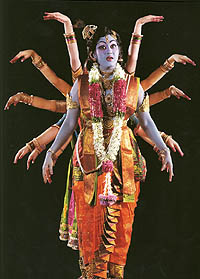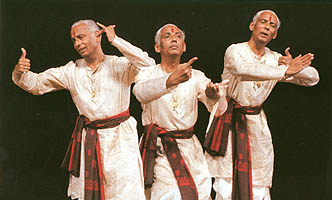Theory of the dance. Hastas and Abhinaya
The Kuchipudi style has a rather extensive and well developed theoretical
foundation. Each aspect of
 Abhinaya,
or the expressive means available to people, is given a detailed description in
such competent treatise as Natyashastra written by the great Bharatamuni. The
Kuchipudi style follows Natyashastra more than any other dance form in India. Abhinaya,
or the expressive means available to people, is given a detailed description in
such competent treatise as Natyashastra written by the great Bharatamuni. The
Kuchipudi style follows Natyashastra more than any other dance form in India.
There are four kinds of abhinaya (means of expression):
1. Angika Abhinaya - the expression through various parts of body.
2. Vachika Abhinaya - the expression through voice, speech and song.
3. Sattvika Abhinaya - the expression through bhavas, i.e. feelings and emotions.
4. Aharya Abhinaya - the expression through costumes, make-up and ornaments.
Every person's life becomes apparent by means of three aspects:
1. Manas - mind
2. Vak - speech
3. Karna - action
These three aspects altogether are called karanas. In dance they are realized as
sattvika, vachika and angika abhinayas respectively.
Sattvika Abhinaya dominates mainly in Nataka (drama), Angika abhinaya is
expressed in Nritta (pure dance, technique) and they are both equally strong in
Nritya (solo dance).
There are three groups in Angika abhinaya:
|
1. Angas:
- shiras (head)
- hastas (gestures)
- vaksha (chest)
- parshva (side)
- kati (hips)
- padas (feet) |
2. Pratyangas:
- skadhae (shoulders)
- bahu (hands)
- prshtam (back)
- udaram (belly)
- uru (the external part of a hip)
- jangha (the upper part of a leg) |
3. Upangas:
- drshti (eyes)
- bhru (brows)
- putta (eyelids)
- kapola (cheeks)
- nasaka (nose)
- hanu (jaw)
- adhara (the lower lip)
- dasana (teeth)
- jihva (tongue)
- vadana (face)
- gulbha (ankle)
- angulya (fingers) |
The movements of
Pratyangas and Upangas always depend on Angas.
Hastas (hand
gestures) are the part of Angika Abhinaya and include the ways of expression
through the physical body (head, eyes, nose, hands etc.). In spite of the fact that the
expression through gestures constitutes the minor part of Angika Abhinaya,
their role is very important. Their meaning is not only decorative but they
are also indicative of the specificity of communication and action in
relation to things.
physical body (head, eyes, nose, hands etc.). In spite of the fact that the
expression through gestures constitutes the minor part of Angika Abhinaya,
their role is very important. Their meaning is not only decorative but they
are also indicative of the specificity of communication and action in
relation to things.
With all that one
should distinguish the notions of hastas and mudras. Although both of them
are hand gestures we will call them hastas while speaking of a technical
aspect of the dance and mudras if it is a necessary to distinguish a certain
gesture in the dance that has a certain meaning.
There are three
kinds of hastas:
1. Asamyuta Hastas
- gestures of one hand carrying a certain semantic load.
2. Samyuta Hastas -
gestures of two hands also having certain meaning.
3. Nritta Hastas -
decorative gestures without a certain meaning and which are the pure dance (technique).
Among the texts on
the theory of dance two most competent sources are distinguished:
Natyashastra and Abhinaya Darpana. There are some differences between them
in either the number of hastas or in the number of their meanings.
Thus Natyashastra
mentions the following number of hastas: Asamyuta Hastas - 24, Samyuta
Hastas - 13 and Nritta Hastas - 27. Abhinaya Darpana mentions 28, 23 and 13
respectively.
According to
Natyashastra, Nritta Hastas are of independent origin while in Abhinaya
Darpana they originate from Asamyuta and Samyuta Hastas.
This is how some
differences in using hastas are explained for example between Kuchipudi and
Bharatanatyam, these styles are simply based on different sources.
The same holds true
for viniyogas i.e. the meaning of hastas. Thus for example in Natyashastra
 they
mention circa 35 different meanings for Pataka hasta while in Abhinaya
Darpana there are more than 40 of them. they
mention circa 35 different meanings for Pataka hasta while in Abhinaya
Darpana there are more than 40 of them.
Besides, the
meanings of hastas are divided into three groups:
1. Natural - the
hastas expressing simple movements: to go, to stop, to eat, to sleep etc.
2. Interpretive -
the gestures imitating the most characteristic features of an object: to
take water from a well, to ride a chariot, animal actions etc.
3. Symbolical - the
gestures destined to portray such notions as beauty, power, opinion, male or
female sex etc.
One can express
almost everything in dance with the help of hastas, but their usage must not
be isolated from the body movements and the meaning must necessarily be
supported by expressions of face and eyes.
| 